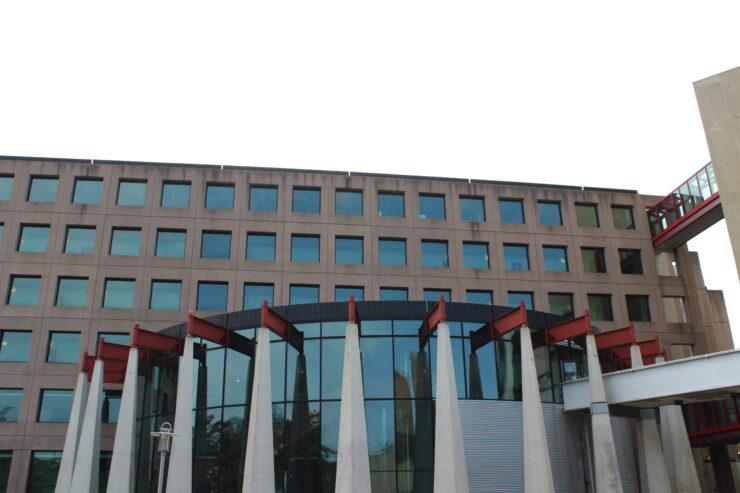Union passes slate of equity stances, anti-discrimination and accessibility policies
The University of Ottawa Students’ Union (UOSU) considered changing the structure of their five-person executive committee, including adding a presidential position, at a Board of Directors (BOD) meeting on Sunday, but after over three hours of debate a number of concerns were raised and the decision was pushed to January.
The board did manage to pass four motions that were tabled at their previous meeting on Nov. 24, including a slate of equity stances, an anti-discrimination policy, and an accessibility policy.
Board votes to strike a Student Coalition Committee
The BOD kicked off their meeting by electing a new chair: Zachary Robichaud, a director for the faculty of social sciences.
They then turned to a motion from faculty of social sciences director Babacar Faye for the union to strike a Student Coalition Committee (SCC), “to create a framework to centralize efforts and campaigns on tuition fees and cuts to OSAP funds,” Faye said.
The motion was tabled at the board’s Nov. 24 meeting after issues were brought up around the composition of the SCC, who would have the authority to call meetings, and what quorum would be for those meetings.
With amendments addressing these concerns added by Faye, the motion passed with one abstention.
Board passes slate of equity stances, anti-discrimination and accessibility policies
The board then looked to pass a motion for the union to adopt a slate of equity stances, a motion that was also tabled at their November meeting after some BOD members raised concerns over the text being available only in English.
The now bilingual motion, brought by the governance committee and drafted by equity commissioner Judy El-Mohtadi, outlines the union’s position on over 10 equity matters, including decolonization and reconciliation, sustainability, and access to education.
El-Mohtadi said each stance will ideally have a corresponding policy, which explains how that position binds the union and how it would look in action.
The board passed the motion unanimously with no abstentions and then looked to adopt two of those corresponding equity policies: one on anti-discrimination and another on accessibility.
The accessibility policy “aims to set out guidelines for the provision of accommodations for people with disabilities while accessing the UOSU’s events or services, while maintaining the dignity and autonomy of people with disabilities,” according to the motion.
The goal of the anti-discrimination policy is to layout “guidelines for the provision of anti-discrimination for everyone while accessing the UOSU’s events or services, while maintaining the dignity and autonomy of those people,” according to the motion.
Both motions passed unanimously with no abstentions and little debate.
Board debates changing structure of executive, adding presidential position
The governance committee brought a motion to change the structure of the UOSU’s current five-person executive to six positions and to also shift the roles of some of the union’s committees, all of which would come into effect in the union’s next term.
The motion proposed creating a presidential role, scrapping the advocacy commissioner position, and creating a student services commissioner position. The roles and mandates of each existing commissioner position would also shift slightly.
Under the proposed amendments to the UOSU constitution, the president would take on many of the duties of the advocacy commissioner, act as the union’s CEO, and hold a leadership role to focus on strategic planning. The student services commissioner would be tasked with overseeing the operations of the UOSU’s services and programs aimed at recognized clubs.
“There are changes to be made to the executive structure and committee structure that would help us operationally,” advocacy commissioner Sam Schroeder said while introducing the motion. “It would make us much more efficient, both as an executive and as an organization.”
Schroeder said he would also welcome keeping the advocacy commissioner position.
Student life commissioner Jason Seguya highlighted the mental health issues he’s experienced on the job while trying to fulfill different mandates when explaining the rationale behind the changes.
“Either I’m not sleeping, I’m in the office to maintain them (the mandates), or projects aren’t being done to the full extent that they should be,” said Seguya. “The expected hours to finish the mandates as is, it’s impossible to maintain without burning yourself out.”
When it came to the presidential position, some directors brought up concerns over a lack of consultation with the student body and the potential of introducing a hierarchical structure, including faculty of engineering director Kimberley Charland and faculty of social sciences director Timothy Gulliver.
Charland pointed out that the change in structure could be seen as reminiscent of the school’s former undergraduate union, the Student Federation of Ottawa (SFUO), which was voted out last winter after allegations of financial mismanagement came to light.
“I think that could rub students the wrong way,” said Charland.
“The issue with the SFUO was never that there was a president, the issue was cultural,” said Schroeder. “That was an issue of poor leadership, as opposed to the structure that was there, and that’s demonstrated by every other student union who has a successful system with the president, vice-president system.”
“In the end, this is a $12-million not-for-profit and if we don’t make changes because of overly cosmetic objections, then we’re going to end up having a non-functioning $12-million not-for-profit,” he added.
Telfer School of Management director Sammy Najm said he wasn’t against the motion but looked to extend the timeline before passing it.
“That $12 million does not come from nowhere, it comes from students, and I do believe that those students who are paying into those $12 million do deserve some consultation,” said Najm.
The board broadly agreed that a decision had to be made on the motion at the next board meeting on Jan. 19 so the election cycle for the UOSU’s next team of executives and directors could get underway with enough time for a transition period.
Charland moved to table the decision until the Jan. 19 meeting, and the motion passed with Schroeder and Seguya voting against.
Charland brought a second motion to instruct operations commissioner Rony Fotsing to call a meeting of the governance committee before Jan. 15 to reconsider the motion, with an online survey sent out to find a concrete time to meet. The motion passed with one voting against and one abstention.
The board then passed a final motion from Schroeder to “strongly recommend” that the election committee not to give notice of the election until after the January board meeting so a decision on whether to change the executive structure could take place.
Meeting adjourned, four other motions tabled until January
With the meeting stretching over five hours and four more motions still on the table, the board passed a motion to adjourn the meeting. The remaining motions on the agenda will be shifted to the UOSU’s first board meeting of the winter semester.
The first tabled motion was brought by the governance committee and looks for the union to adopt a linguistic policy, recognizing that it is the UOSU’s responsibility to “represent, defend and ensure respect for the language rights of students within the university community.”
The three remaining motions were brought by faculty of social sciences director Gulliver.
One motion looks to establish a policy on director attendance to board meetings and another proposes the UOSU give an update on the financing of the anti-abortion group U of O Students for Life, which has been at the centre of controversy over the past few months.
The third motion from Gulliver proposes the equity committee review the General Assembly which took place on Saturday, “to discuss how to make those spaces more safe and respectful for all members, especially when dealing with sensitive issues,” he explained.
The UOSU’s BOD will meet next on Jan. 19, location and time to be announced.





